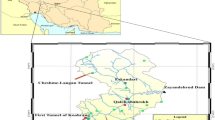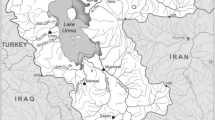Abstract
Accurate prediction and monitoring of water level in reservoirs is an important task for the planning, designing, and construction of river-shore structures, and in taking decisions regarding irrigation management and domestic water supply. In this work, a novel probabilistic nonlinear approach based on a hybrid Bayesian network model with exponential residual correction has been proposed for prediction of reservoir water level on daily basis. The proposed approach has been implemented for forecasting daily water levels of Mayurakshi reservoir (Jharkhand, India), using a historic data set of 22 years. A comparative study has also been carried out with linear model (ARIMA) and nonlinear approaches (ANN, standard Bayesian network (BN)) in terms of various performance measures. The proposed approach is comparable with the observed values on every aspect of prediction, and can be applied in case of scarce data, particularly when forcing parameters such as precipitation and other meteorological data are not available.





Similar content being viewed by others
References
Aguilera P, Fernández A, Fernández R, Rumí R, Salmerón A (2011) Bayesian networks in environmental modelling. Environ Modell Softw 26(12):1376–1388
Altunkaynak A (2007) Forecasting surface water level fluctuations of lake van by artificial neural networks. Water Resour Manag 21(2):399–408
Atkinson KE (2008) An introduction to numerical analysis. Wiley
Bates B, Kundzewicz ZW, Wu S, Palutikof J et al (2008) Climate change and water, Intergovernmental Panel on Climate Change (IPCC)
Buyukyildiz M, Tezel G, Yilmaz V (2014) Estimation of the change in lake water level by artificial intelligence methods. Water Resour Manag 28(13):4747–4763
Chamoglou M, Papadimitriou T, Kagalou I (2014) Key-descriptors for the functioning of a mediterranean reservoir: the case of the new lake karla-Greece. Environ Process 1(2):127–135
Chang FJ, Chang YT (2006) Adaptive neuro-fuzzy inference system for prediction of water level in reservoir. Adv Water Resour 29(1):1–10
Chang LC, Chang FJ (2001) Intelligent control for modelling of real-time reservoir operation. Hydrol Process 15(9):1621–1634
Chaves P, Chang FJ (2008) Intelligent reservoir operation system based on evolving artificial neural networks. Adv Water Resour 31(6):926–936
Christensen NS, Wood AW, Voisin N, Lettenmaier DP, Palmer RN (2004) The effects of climate change on the hydrology and water resources of the colorado river basin. Clim Chang 62(1-3):337–363
Çimen M, Kisi O (2009) Comparison of two different data-driven techniques in modeling lake level fluctuations in Turkey. J Hydrol 378(3):253–262
CWC (2015) Compendium on silting of reservoirs in India. cwc (central water commission) report. 2015. ws & rs directorate, emo, cwc. new delhi. www.cwc.nic.in/main/downloads/CoSoR2015.pdf, [Online; Accessed 18-Jun-2015]
Das M, Ghosh SK (2014) A probabilistic approach for weather forecast using spatio-temporal inter-relationships among climate variables. In: 9Th IEEE international conference on industrial and information systems. IEEE, Gwalior, India, pp 15–17
Everitt BS (2002) The Cambridge Dictionary of Statistics, 2nd edn. Cambridge University Press. ISBN 0-521-81099-X
Fu L, Qi J (2008) A residual correction method for iterative reconstruction with inaccurate system model. In: 5th IEEE International Symposium on Biomedical Imaging: From Nano to Macro 2008. ISBI 2008. IEEE, pp 1311–1314
Getoor L, Rhee JT, Koller D, Small P (2004) Understanding tuberculosis epidemiology using structured statistical models. Artif Intell Med 30(3):233–256
Ishak WHW, Mahamud KRK, Norwawi NM (2012) Modelling reservoir water release decision using temporal data mining and neural network. Int J Emerg Technol Adv Eng 2(8):422–428
Kisi O, Shiri J, Nikoofar B (2012) Forecasting daily lake levels using artificial intelligence approaches. Comput Geosci 41:169–180
Maier HR, Jain A, Dandy GC, Sudheer KP (2010) Methods used for the development of neural networks for the prediction of water resource variables in river systems: current status and future directions. Environ Modell Softw 25(8):891–909
McNider R, Handyside C, Doty K, Ellenburg W, Cruise J, Christy J, Moss D, Sharda V, Hoogenboom G (2014) An integrated crop and hydrologic modeling system to estimate hydrologic impacts of crop irrigation demands. Environmental Modelling & Software
Mustafa MR, Isa MH, Rezaur RB (2012) Artificial neural networks modeling in water resources engineering: infrastructure and applications. World Acad Sci Eng Technol 62:341–349
Ondimu S, Murase H (2007) Reservoir level forecasting using neural networks: Lake naivasha. Biosyst Eng 96(1):135–138
Ordóñez Galán C, Matías JM, Rivas T, Bastante F (2009) Reforestation planning using bayesian networks. Environ Modell Softw 24(11):1285–1292
Panagopoulos Y, Georgiou E, Grammatikogiannis A, Polizoi E, Mimikou M (2008) Impacts of human interaction on the sediment transport processes in the arachtos river basin, western Greece. Eur Water 21(22):3–16
Piao S, Ciais P, Huang Y, Shen Z, Peng S, Li J, Zhou L, Liu H, Ma Y, Ding Y et al (2010) The impacts of climate change on water resources and agriculture in China. Nature 467(7311):43–51
Poff NL, Olden JD, Merritt DM, Pepin DM (2007) Homogenization of regional river dynamics by dams and global biodiversity implications. Proc Nat Acad Sci 104(14):5732–5737
Postel S, Richter B (2012) Rivers for life: managing water for people and nature. Island Press
Russell SJ, Norvig P, Canny JF, Malik JM (2003) Artificial intelligence: A modern approach. Prentice Hall Series
Santafé G, Lozano JA, Larrañaga P (2007) Discriminative vs. generative learning of bayesian network classifiers. In: Symbolic and Quantitative Approaches to Reasoning with Uncertainty. Springer, pp 453–464
Author information
Authors and Affiliations
Corresponding author
Ethics declarations
Conflict of Interests
The authors have no conflict of interest.
Rights and permissions
About this article
Cite this article
Das, M., Ghosh, S.K., Chowdary, V.M. et al. A Probabilistic Nonlinear Model for Forecasting Daily Water Level in Reservoir. Water Resour Manage 30, 3107–3122 (2016). https://doi.org/10.1007/s11269-016-1334-6
Received:
Accepted:
Published:
Issue Date:
DOI: https://doi.org/10.1007/s11269-016-1334-6




